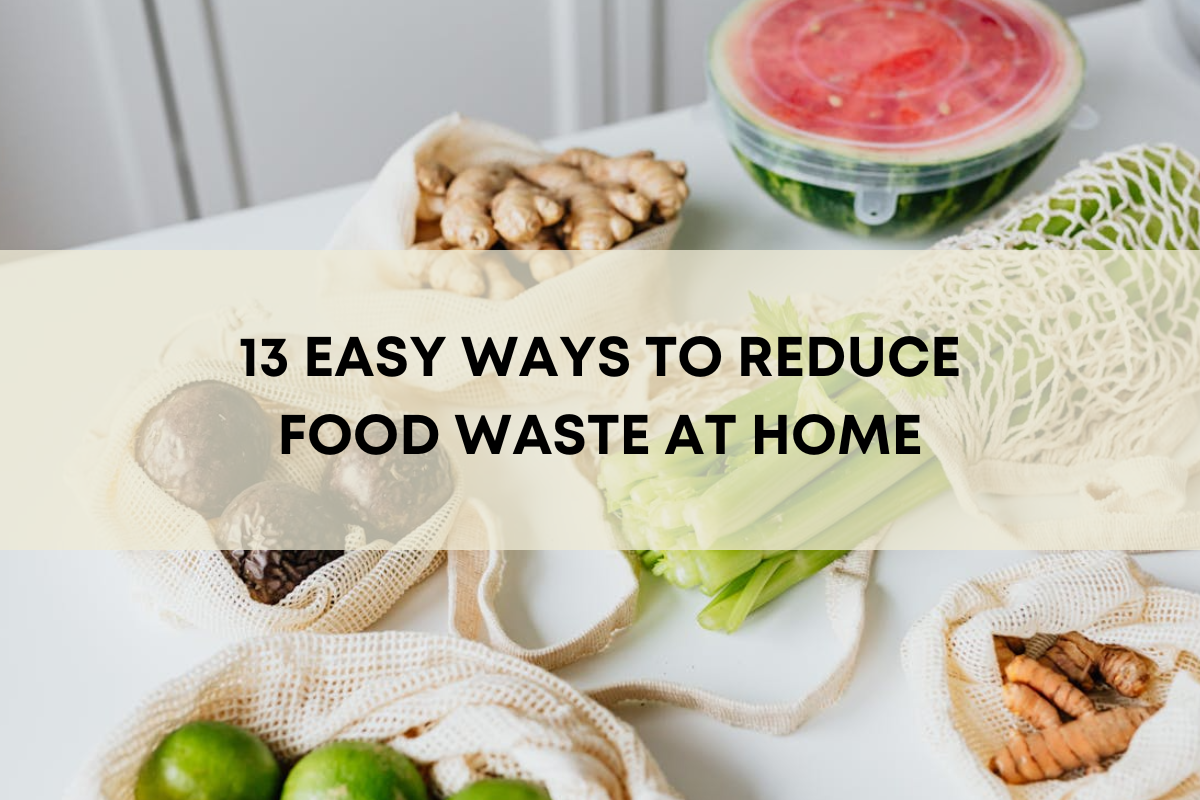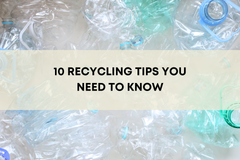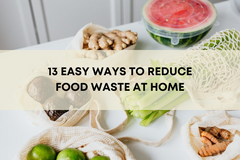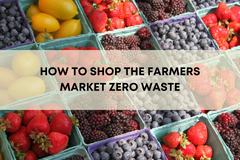13 Easy Ways to Reduce Food Waste at Home

Food waste isn’t just about throwing away leftovers — it’s a big environmental issue. In the U.S., we waste roughly between 30-40% of our food supply, and most of it ends up in landfills, creating harmful methane emissions. (1) The good news? Small shifts in our habits can make a huge difference.
In 2022, ReFed estimates that over 88.7 million tons of food went unsold or uneaten in the United States – roughly 38% of the country’s total food supply. (2) Food scraps are the largest contributors to methane, a greenhouse gas far more potent than CO₂, accounting for 58% of landfill methane emissions, despite food only making up about 24% of landfill waste. (3)
In honor of the Stop Food Waste Challenge this month, here are some easy, everyday ways to reduce food waste right in your own kitchen so we can begin making a difference directly from our own homes:
1. Keep a “use me first” bin in the fridge
Designate a small container or basket for foods that need to be eaten soon. Place it front-and-center in your fridge so nothing gets forgotten.
2. Store food where you can see it
If it’s hidden in the back of the fridge or buried in the pantry, you’re more likely to forget about it. Clear containers and front-facing shelves are your friend!
3. Learn proper storage for produce
Some veggies last longer in the fridge, while others prefer the counter. Some produce also shouldn’t be stored together as they can spoil each other. Here are just a few examples:
-
Leafy greens love to be stored in the fridge with a damp towel — or check out our Vegetable Crisper Bags, which help prolong the life of your leafy greens by up to two weeks!
-
Tomatoes actually should not be stored in the fridge — they love the counter!
-
Onions, apples, bananas and tomatoes all release ethylene gas that speed up the ripening process — DO NOT store these items together, otherwise they can spoil much faster. Store these all separately to keep them for longer.
There are SO many produce storing tips to help your food last much longer. We love this Food Storage Cheat Sheet by the Saint Paul Public Works, but sub the plastic bags for reusable storage bags and containers. Check it out!
4. Compost what you can’t eat
Instead of tossing food scraps, compost them into nutrient-rich soil. Whether you use a backyard bin, worm bin, or city compost service, it’s a game-changer and helps food scraps break down properly in the right setting.
It’s easy to start — check out our Composting 101 guide here and some additional resources below:
5. Save veggie and meat scraps for broth
Freeze carrot tops, onion skins, celery ends, and other vegetable odds and ends with leftover meat scraps and bones in a bag. Once full, you can simmer them into a flavorful broth. This is a great way to save scraps and repurpose them. Once used up, compost the cooked scraps!
6. Reimagine leftovers
Inject some creativity into your daily meals by reimaging your leftovers. Sick of eating your 3rd meal of roasted veggies? Add them into a frittata for breakfast! Got a lot of leftover rice? Stir it into a soup. Got too many ripe fruits? Throw them into a blender and create a yummy smoothie instead. Or, if you’re not ready — cut them up and freeze them for a smoothie another day.
7. Take inventory and plan meals before you shop
Shopping with a plan helps you buy exactly what you need and prevents food from sitting unused. Take inventory of what you already have in your pantry and fridge before you go shopping so you only buy what you need to cook this week’s meals. Having a shopping list also prevents you from buying anything unneeded — stick to the list!
Tip: Supercook is a great way for you to plan meals by using up the groceries you already have. Simply select all of the ingredients you have on hand, and it’ll scour the internet for recipes that are compatible with what you have.
8. Embrace “ugly” produce
That misshapen carrot or bruised apple is just as tasty as the one that looks perfect. Use them in cooking, baking, or smoothies. There are also produce delivery programs like Misfit Markets or Imperfect Foods that strive specifically to save foods that grocery stores don’t want to put out — mislabeled pasta boxes, “ugly” fruit and veggies, and even produce that are too small or too large!
9. Buy in smaller quantities
If you often find yourself throwing food away, consider buying smaller amounts more often, or finding ways to use it up or save for next time.
For example, herbs like rosemary and basil can be frozen in olive oil in an ice cube tray for future use.
10. Use your freezer wisely
Your freezer is your friend! But it shouldn’t be where things go to get freezer burned. The freezer is a great spot for you to prolong your food even longer or help meal prep. Here are a few examples:
-
Freeze bread before it molds! To make things easier, slice your bread before wrapping up to place into the freezer. When you want some bread, simply pop a slice in the toaster, and enjoy!
-
Meal prep breakfast burritos, or even pre-marinated meats for future meals in your freezer. This is a great way to use up foods that may be nearing their expiry date.
11. Understand “best by” vs. “use by” dates
These labels are about quality, not safety. Many foods are fine to eat past their date — use your senses to decide.
-
“Best By” dates indicate when a product will be of best flavor and quality. It is not a purchase or safety date, which means you can still enjoy the item AFTER this date.
-
“Use By” dates are the last date recommended for use of the product while it’s at peak quality. It is not a safety date either.
-
“Sell By” dates tell the store how long to display the product for sale for inventory management purposes. It is also not a safety date.
That means, even if your food or produce passes these marked dates, the product should still be safe to consume if it has been stored and handled properly. It’s important to check for signs of spoilage (odor, appearance, texture) before consuming. (4)
12. Revive wilted veggies
Wilted veggies are not a sign that they are bad or cannot be eaten! They just need some water: soak limp greens, carrots, or celery in ice water for 10–15 minutes to bring them back to life.
Keeping cut carrots and celery sticks in mason jars filled with water are a great way to store them and keep them from drying out! Or, use the Vegetable Crisper Bag to keep them damp at all times, so they never wilt on you.
13. Get creative with “scrap” recipes
There are so many uses for your scraps, and aside from saving veggie scraps for broth, here are a few more creative ideas:
-
Use your leftover citrus peels for zest or make your own cleaning solution
-
Keep any stale, hard bread and make croutons from them — these are so much better than store-bought!
-
Got watermelon rinds? Why not candy them?
Reducing food waste doesn’t have to be overwhelming. Pick one or two tips to try this week, and keep building from there. Each small change adds up to a big impact over time.
Not only does reducing food waste help you save money, but it also helps you and your family eat better and healthier. In the long run, it’s a win-win for both you & the planet.
If you are in Hennepin County, we highly recommend checking out the Stop Food Waste Challenge, a virtual challenge that happens every August. You receive a number of different resources to reduce food waste in your home & community and can earn points in the challenge by completing certain tasks like meal-prepping for the week, or only buying what was on your grocery list.
Thank you for joining us on the zero waste journey and helping make a difference for the planet!
Sources:
-
United States 2030 Food Loss and Waste Reduction Goal | https://www.epa.gov/sustainable-management-food/united-states-2030-food-loss-and-waste-reduction-goal?
-
Insights from ReFED's Food Loss and Waste Estimates for 2022 | https://refed.org/articles/slow-progress-big-opportunities-in-food-waste-reduction-insights-from-refed-s-food-loss-and-waste-estimates-for-2022/?
-
Quantifying Methane Emissions from Landfilled Food Waste | https://www.epa.gov/land-research/quantifying-methane-emissions-landfilled-food-waste?
-
Food Product Dating | https://www.fsis.usda.gov/food-safety/safe-food-handling-and-preparation/food-safety-basics/food-product-dating
Recent Blog Posts
Discover more tips on living #ZeroWaste!
-

10 Recycling Tips You Need To Know
Recycling can be simple, but small mistakes can contaminate your recyclables and reduce their impact. In this guide, we share 10 practical tips to help you recycle smarter, from...
Read more -

13 Easy Ways to Reduce Food Waste at Home
In the US, up to 40% of food goes uneaten — but small, everyday changes can make a big impact. From smarter storage to creative recipes for leftovers, these tips will help you w...
Read more -

How To Shop The Farmers Market Zero Waste
Farmers Markets are full of fresh produce and local goods—but they can also be full of packaging waste if you're not prepared. Learn how to shop zero waste with practical tips l...
Read more



